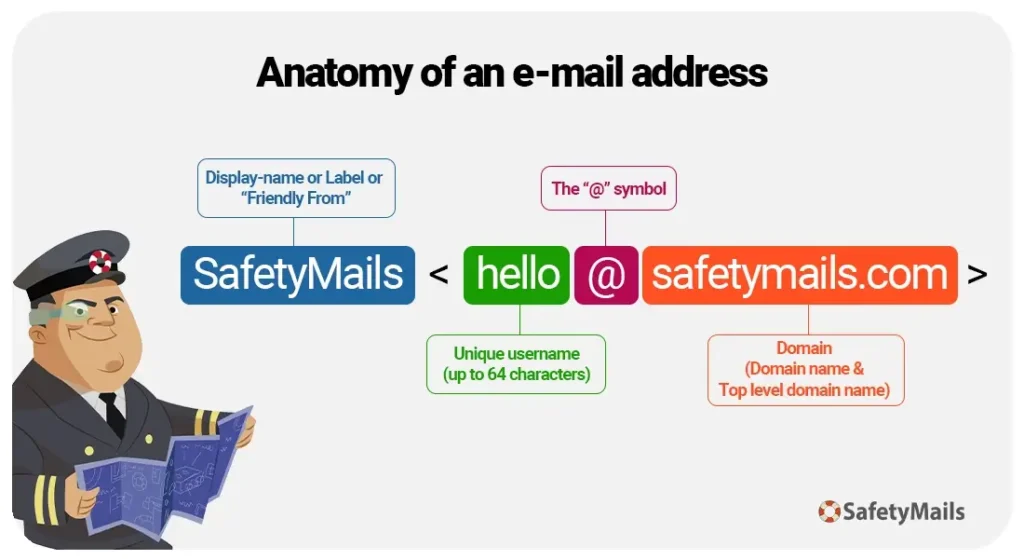The difference between email validation and verification is that they are two different processes: email validation concerns aspects of the structure and formatting of the email address. Email verification goes further and examines whether the email actually exists and is active.
Although they refer to two different processes, both have very similar purposes: maintaining the quality of email lists, seeking to reduce hard bounce rates in email marketing campaigns.
between the two, there is no better or worse: both are essential for maintaining the quality of email lists. This is because, after all, email marketing is a powerful part of digital marketing strategies, responsible for a considerable share of sales conversions and email lists can represent success or a succession of problems, depending on their quality.

Table of contents
What is email validation?
Several online services, such as SafetyMails, define themselves as “email validation and verification platforms”. In other words, they are dedicated to carrying out both processes. Normally, email verification already has email validation implicitly.
But what exactly is email validation and how does it work?
In terms of definition, email validation aims to analyze and validate the structure and format of an email address, its correct formatting, the presence of allowed characters, its domain and its suitability for the market’s RFCs (technical reference documents).

An e-mail address has the following structure in a nutshell: username, which must be unique in a domain, followed by the “@” sign (at, which here has the meaning of “at”), and the domain with its extension. To see this structure in more detail, we recommend reading SafetyMails blog post.
There are three main processes involved in email validation:
- Syntax analysis: the system or website analyzes the formatting patterns of the e-mail address submitted. So, for example, if there is no “@” sign, this already invalidates the email as a hard bounce.
- Domain analysis: in this step, the system or website analyzes whether the domain of the e-mail address exists (is active) and whether it is correctly configured to send and receive e-mails (a domain can exist and not be able to receive e-mails).
- Address type analysis: the e-mail address may have the correct structure and formatting characteristics and still not meet the minimum requirements. This is the case with temporary emails, junk emails and spamtraps.
- Temporary emails: emails that are only valid for a few minutes, hours or days. It is important that registration forms do not accept these types of emails, as they become hard bounces and damage results.
- Junk: emails with correct syntax, but which have characteristics that can be blocked by anti-spam tools with heuristic filters. An example of this are email names with swear words.
- Spamtraps: This type of email is highly damaging. It has the correct syntax and is totally valid, but sending messages to it is a guarantee of blocking and blacklisting. It should therefore be prevented from being sent at the time of registration.
Benefits of email validation
Email validation brings benefits, provided it is done at the right time. And perhaps the most important of these is the moment of registration.
In other words, making sure that emails are validated directly in the registration forms is essential.
With email validation, you get the following benefits:
- Guarantee that the addresses collected are formatted correctly.
- Prevention ofcommon mistakes, such as incorrect typing.
- Protection against poor quality email addresses from the start.
To apply validation in this case, you can use syntax criticism programming, which is very common, or install an API that performs this validation in real time.
The important thing is that, whatever the reason for the error identified, the visitor is notified immediately in time to correct the e-mail address.
Limitations of email validation
Although it is an indispensable step, it is not enough to determine whether an e-mail address is safe for e-mail marketing campaigns. Among the limitations of the validation are:
- Validation does not guarantee that the e-mail really exists or is active.
- Validation does not check if the recipient is active or if the e-mail address may pose any delivery difficulties.
To overcome the limitations of email validation, there is also the email verification process.

What is Email Verification?
Once an email has been validated, i.e. its syntax has been evaluated and confirmed as correct, it’s time to move on with the process, adding layers of qualification.
Email verification goes beyond structural analysis, as at this stage it focuses on confirming the existence of the email and its activity.
This stage may (or may not) involve interaction with email servers
Among the processes involved in this stage are:
- Identification of inactive or misconfigured servers: Once the domain has been validated, it’s time to make sure that the technical configurations for receiving and storing e-mails are functional and free of problems or intermittencies.
- Verification of user existence: In this step, you can analyze whether the recipient of the entered e-mail address (or local-part) exists in the entered domain.
- Delivery capacity: when the recipient is confirmed, it is also possible to find out, through behavioral analysis, whether a particular email address may experience email delivery problems.
- Status qualification: Finally, once you’ve gone through all the steps, it’s time to classify the emails as valid, invalid and so on.
Advantages of email verification
Email verification is fundamental to email marketing because it brings benefits such as:
- Reduction in hard bounce rates: with verified e-mail addresses, the error rates (hard bounces) will be drastically reduced (and even zeroed out).
- Maintaining reputation and deliverability: by sending to quality lists (without bounces), the reputation of sending IPs and domains will improve, helping to reduce blocks and increase deliverability (number of messages that go to the inbox instead of the spam folder).
- Better accuracy of mailing lists: Verified email lists have email addresses that can be correctly targeted by email marketing campaigns, leading to more conversions.
Essential differences between email validation and verification
Email validation and verification are two important stages in email classification. They differ but complement each other.
See the comparative summary below:
| Email validation | E-mail verification | |
| Escopo: | More superficial: analysis of format and syntax. | More in-depth, checking the existence and quality of the e-mail. |
| Target: | Ensure that the e-mail is typed correctly and has the right structure. | It seeks to ensure that e-mail can actually be used for contact. |
| When to apply: | At the time of data collection (registration forms) or in list cleaning routines. | At the time of data collection (registration forms), in list cleaning routines or re-evaluation of legacy or inherited lists. |
| Tools and methods: | Form criticism, through field validation. Validation and verification tools (SafetyMails). | Double opt-in. Email validation and verification tools (SafetyMails). |
When to use email validation and verification?
Basically, any time email address data is processed or used, it should be considered as an opportunity to carry out email validation and verification.
Let’s list three main moments:
- During data collection: when filling in registration forms, it is essential to ensure that email records are collected correctly, preventing errors already at the source of the data, and optimizing the leads generated.
- Before sending email campaigns: Letting the quality of e-mail lists be assessed by e-mail providers alone is a danger to reputation. Harmful emails (invalid, junk, spamtraps, temporary) need to be removed before they are sent, preventing impacts on delivery rates and the sender’s reputation.
- In e-mail list maintenance routines: Even lists that have already been validated need to be rechecked (REF LV3 16 or 17) periodically, in order to remove e-mail addresses that have been deactivated, for example. In addition, perform validation and verification routines whenever there is contact with a new list (legacy or inherited).

Conclusion
While validation acts as a first layer of protection by ensuring that email addresses are formatted correctly, verification goes deeper by ensuring that these addresses are active and can receive messages.
The combination of these steps prevents problems such as hard bounces and low deliverability, and also protects the sender’s reputation, increases engagement and optimizes the results of email marketing campaigns.
Therefore, investing in regular email validation and verification processes is a recommended and indispensable practice for long-term success in email marketing.
FAQ
What is the main difference between email validation and verification?
Email validation checks the structure and formatting of an address, ensuring that it complies with basic syntax rules, such as the presence of the “@” symbol. Verification goes further, analyzing whether the email really exists and is active, ensuring that it can receive messages. So, while validation is more superficial, verification is a more in-depth process.
Why is it important to validate and verify emails in marketing campaigns?
These processes reduce problems with low-quality addresses, prevent hard bounce rates and improve the deliverability of campaigns. A clean email list increases the chances of success by ensuring that messages reach real inboxes, avoiding negative impacts on the reputation and effectiveness of campaigns.
How does email validation contribute to list quality?
Validation ensures that the emails collected are formatted correctly, avoiding typos and the inclusion of invalid addresses. When applied to registration forms, validation acts as an initial filter, preventing problematic addresses from entering the list and ensuring greater accuracy in the contacts stored.
Can email verification guarantee that all emails are valid?
Although verification significantly improves the quality of lists, it does not guarantee 100% accuracy, as some mail servers may reject verification requests. Even so, verification drastically reduces the number of invalid addresses, increasing sending confidence and reducing the risk of bounces and reputational impact.
When is the best time to validate and verify emails?
Ideally, validation should be applied at the time of collection, i.e. when filling in registration forms, to avoid wrong addresses being entered into the database. Verification, in turn, is recommended before any sending campaign and in list maintenance routines, especially when there are legacy or inactive emails.
Is validation and verification enough to avoid deliverability problems?
These processes are fundamental to reducing deliverability problems, but they must be complemented by other practices, such as double opt-in, to ensure that recipients authorize the receipt of emails. In addition, maintaining a consistent sending frequency and relevant content also helps to keep deliverability high.
What tools can be used to validate and verify emails?
There are several tools, such as SafetyMails, that offer both email validation and verification. These tools analyze the syntax, domain, existence and activity of addresses, helping companies to maintain quality lists and improve the performance of email marketing campaigns.



